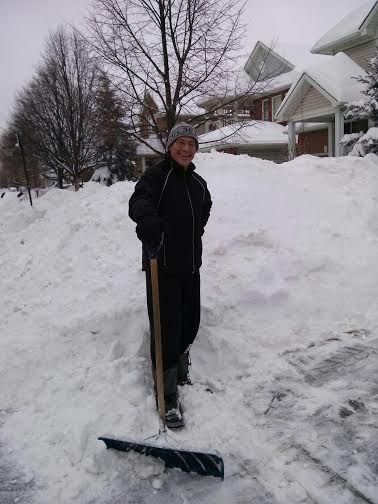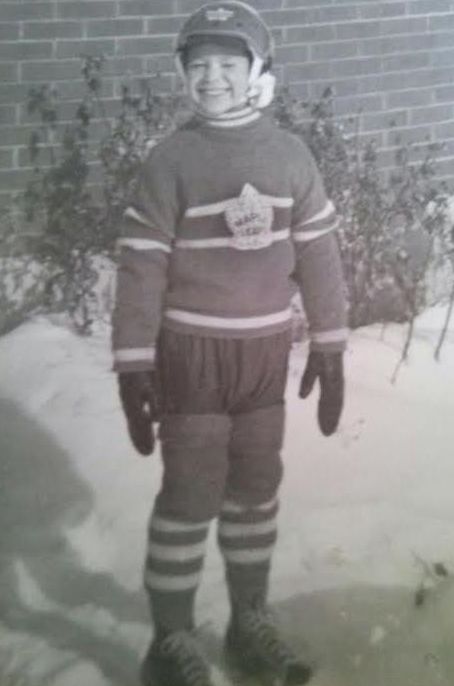FOLLOW BRAD ON TWITTER: @BRADMARSHNHL

I just finished shoveling my driveway as I sit down to write this week's blog. It took five hours. It was our first major snow storm of the hit the Ottawa area last night. Most people dread the snow, especially the snow storms. Not me. I love it!
I especially love shoveling the snow, my driveway is bare right down to the pavement during the entire winter. And for the record I also shovel off my deck, so I can BBQ throughout the winter.
By winter’s end I will have an Igloo type man-cave sculpted around my BBQ. I like the snow and I always welcomed the snow, especially the first blizzard, because when I was a kid it always signaled the start of the hockey season.
No, not the NHL hockey season. I'm talking about the outdoor hockey season. With the first snow, it always brought the excitement that the rink that my dad made for my brothers and me would soon be built.
The cold weather that accompanied the change in scenery also meant that not only was the front yard rink going to made but the corner pond at Cotswold Gate was soon going to frozen over as well!
The excitement of the first snow turned to jubilation if it was the right snow. If it was the right snow that simply meant that the rink would be built sooner, if it was the wrong snow then we would have a little more work to do.

You often hear the term “backyard rink.” Well, our rink at 178 Baseline Rd W was built in the front yard because we had several apple trees and a great big willow tree in the backyard, which made it impossible to build it in the back yard.
Didn’t matter to us. Our front yard was big, so our rink was also big which meant there was lots of room for the Marsh boys and all of our friends to play hockey.
The only thing that you had to worry about was the fire hydrant in the middle of the rink. I guess you could say that fire hydrant sure taught us to keep our heads up at an early age!
The making of the rink took a lot of patience, which as kids we had none of. The first step of out door rink making is packing down the snow, this where the type of snow is important. If it is the heavy wet kind then you are away to the races because it packs down nice, if it is light and
fluffy – you have a lot of work to do.
You begin making the rink by tramping down the snow, which is easier said then done - believe me, especially with my dad watching every step! The key to the first step s to get the surface as smooth as possible prior to that first flood. If time in the last 12 wasn’t smooth then that meant there would have to be several extra floods to get it smooth before you could skate on it.
Finally we are ready for the flooding stage. This stage was most often done very late at night. Why? Because it was colder and the water would freeze quicker. The water my Dad used for the flooding came from the basement wash tub, the summer garden hose was attached to the faucet. The hose was then stretched through the basement and out the basement window to the front yard, me and my brothers always thought that this was so cool! It was our job to stretch out the hose and to make sure that there was not any kinks in it and to guide it through the open window.
We were not part of the actual flooding, probably because we would all be fighting over who got to hold the hose. After the first flood, it was our bed time - leaving my dad and the hose to fend
for themselves.
When we woke up the next morning and the first question that we asked was “Can we skate yet?”
“No, it’s not ready," was the inevitable reply.
“When?”
“I’ll let you know. And don’t be walking on it!”
If you walked on the ice before it was ready – you would break through or collapse the ice. Which meant a whole lot of repair work before you could flood again. As a kid, I remember standing looking at the ice – it looked ready, maybe I should try it, just one boot with only half my weight on the ice. If it didn’t crack then I would test it with both feet and all of my weight – I would then be the first to run and tell my dad that the ice was ready.
But what if it cracked? I would be in big trouble. It wasn’t worth it.
Ultimately, I decided, "Guess I’ll just wait until my dad says it is ready."
The flooding stage could take anywhere from a couple of nights to a week, it would all depend on the temperature at night. It needed to be real cold for consecutive nights in order to build a real solid base. The base was key because the bigger the base the longer the rink lasted.
Well, eventually the rink was ready to go and we skated as much as we could – morning, noon and into the early evening. Our rink was always full, we were always on it and so was most of the neighbourhood – a lot of fun and a lot of memories! Bring on the snow.
I didn’t get to build an outdoor rink for my kids until I retired and decided to stay here in Ottawa. It wasn’t because I did not have the time while I was playing – it simply wasn’t cold enough to be able to build a rink. I tried in Toronto and in Detroit but I could never get anywhere. When it did snow, I could pack the snow down but it was never cold enough to be able to flood and build a proper base. Well, at least I tried.
Even the process of trying to build a rink was a lot of fun. The house that we lived in here in Ottawa did not have a very large yard. The back yard was hilly and the front yard was very small. But that did not stop me, we built a rink – it was small but it served it purpose. I am not sure who enjoyed it more – me or the kids!
The “back yard” or “front yard” rink is still very common throughout Canada but like everything else they have evolved. While many parents continue to build a very simple rink like the one that I skated on as a kid, some parents are over the top.
The new age backyard rink, many are complete with their own boards, red and blue lines along with their favourite teams logo is painted on the ice. Real goalie nets are in placed as opposed to your boots. Heated sheds are very popular for the kids to change into their skates – heaven for bid that little Johnny get his feet cold! In fact, many rinks even have a portable refrigeration that is used – my dad would roll over in his grave!
On a side note, just to help you understand how much hockey or the hockey rink plays means to our Canadian culture, here in Ottawa, aside from all of the indoor rinks that we have, the city builds and maintains 247 outdoor rinks. That is right, there is a city crew or several of them
that goes through the same process that my dad did night after night here in Ottawa. And what is neat, they are all used – it is really neat to watch or participate in a game of shinny.
Shinny is what we call our hockey when there is no rules, no refs, and no whistles.
And on top of all that we have the Rideau Canal which is 8.1 kilometres long and is flooded and Zambonied each night, sorry no hockey allowed just ice skating. However, there is one exception each year the Senators Alumni are allowed to play a game on the canal.
Fun! Pure fun. It takes you back again to that feeling of being a kid.

